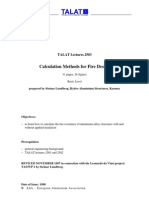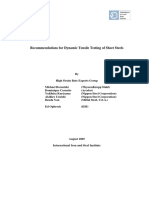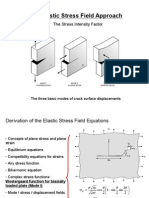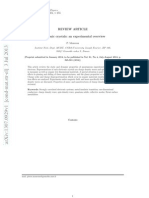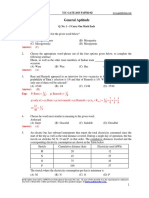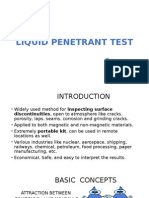Mak 214 Soru 3
Mak 214 Soru 3
Uploaded by
skeletonkey11Copyright:
Available Formats
Mak 214 Soru 3
Mak 214 Soru 3
Uploaded by
skeletonkey11Original Title
Copyright
Available Formats
Share this document
Did you find this document useful?
Is this content inappropriate?
Copyright:
Available Formats
Mak 214 Soru 3
Mak 214 Soru 3
Uploaded by
skeletonkey11Copyright:
Available Formats
MS 115b: Fundamentals of Materials Science
Solutions 2 (60pts)
13.2 (10pts) A large thick plate of steel is examined by X-ray methods, and found to contain no detectable cracks. The equipment can detect a single edge-crack of depth a = 5mm or greater. The steel has a fracture toughness
-3/2 -2
KC
of 40MNm and a yield strength of 500 MNm . Assuming that the plate contains cracks on the limit of detection, determine whether the plate will undergo general yield or will fail by fast fracture before general yielding occurs. What is the stress at which fast fracture would occur? Calculate the stress for failure by (a) general yield and (b) fast fracture. (a) (b)
= 500MNm 2
=
for general yield.
KC 40 = = 319MNm 2 , a 0.005
for fast fracture, assuming that a crack on the limit of detection is present. The plate will fail by fast fracture before it fails by general yield. Answer : Failure by fast fracture at 319MNm-2
13.3 (10pts) The fuselage of a passenger aircraft can be considered to be an internally pressurized thin walled tube of diameter 7 m and wall thickness 3 mm. It is made from aluminum alloy plate with a fracture toughness
-3/2 -2
K C of
100MNm . At cruising altitude, the internal gauge pressure is 0.06MNm . Multiple fatigue cracks initiated at a horizontal row of rivet holes, and linked to form a single long axial through thickness crack in the fuselage. Estimate the critical length at which this crack will run, resulting in the break-up of the fuselage.
pr 0.06MNm 2 0.5 7000mm = = 70MNm 2 , t 3mm
KC = Y a , Y = 1
1K 1 100MNm 3/ 2 a= C = = 0.65m 70MNm 2
2 2
r
t
Answer : 0.65m.
16.3 (10pts) In order to test the strength of a ceramic, cylindrical specimens of length 25 mm and diameter 5mm are put into axial tension. The tensile stress which causes 50 percent of the specimens to break is 120MNm-2. Cylindrical ceramic components of length 50 mm and diameter 11 mm are required to withstand an axial tensile stress
with a survival probability of 99 percent. Given that m=5, use equation (16.7) to determine
1.
V m V (11/ 2) 2 mm 2 50mm = = 9.7 PS (V ) = exp , V0 0 V0 (5 / 2) 2 mm 2 25mm
For the test specimens, eqn (16.7) gives
1 120MNm 2 5 120MNm 2 , 0 = = 129MNm 2 PS (V0 ) = 0.5 = exp 1/ 5 1 0 ( ln 0.5)
For the components, eqn (16.7) gives
5 1/ 5 1 1 2 ln 0.99 2 PS (V ) = 0.99 = exp 9.7 , = 129MNm = 32.6MNm 129MNm 2 9.7
Answer : 32.6 MNm-2 17.1 (10pts) A component is made of a steel for which K C = 54MNm
3/ 2
. Non-destructive testing by ultrasonic
methods shows that the component contains cracks of up to 2a = 0.2mm in length. Laboratory tests show that the crack-growth rate under cyclic loading is given by
da 4 = A ( K ) dN
where
A = 4 1013 (MNm 2 ) 4 m 1 . The component is subjected to an alternating stress of range
= 180MNm 2
about a mean tensile stress of /2 . Given that Catastrophic failure will occur when
K = a , calculate the number of cycles to failure.
180MNm -2 a f = 54MNm -2 ,
Now
a f = 0.029m
da 1 1 4 = A ( K ) = A( ) 4 2 a 2 , dN = 2 da , B A( )4 2 = 4.14 103 m 1 4 2 dN A( ) a
Nf
dN = N f 0 =
1 1 2 da a0 B a 1 11 1 1 1 6 = = 3 = 2.4 10 B a f a0 4.14 10 0.029 0.0001
af
Answer :
2.4 106 cycles
17.2 (10pts) An aluminum alloy for an airframe component was tested in the laboratory under an applied stress which varied sinusoidally with time about a mean stress of zero. The alloy failed under a stress range, , of 280MNm-2 after 105 cycles; under a range of 200MNm-2, the alloy failed after 107 cycles. Assuming that the fatigue behaviour of the alloy can be represented by
( N f ) = C
a
where a and C are material constants, find the number of cycles to failure. stress range of 150MNm-2.
N f for a component subjected to a
280MNm 2 (105 ) = C , 200MNm 2 (107 ) = C
a a
a=
0.073 1 1 280 = 649MNm 2 , C = 280MNm 2 (105 ) log = 0.073 = 2 200 13.7
1/ a
C Nf =
Answer :
649 = 150
13.7
= 5.2 108
5.2 108 cycles
20.2 (10pts) An alloy tie bar in a chemical plant has been designed to withstand a stress
12 1
of
25MNm-2 at 620C.
Creep tests carried out on specimens of the alloy under these conditions indicated a steady-state creep rate,
, of
3.110 s . In service it was found that, for 30 percent of the running time, the stress and temperature increased to 30MNm-2 and 650C. Calculate the average creep rate under service conditions. It may be assumed that the alloy creeps according to the equation
= A 5 e Q / RT
where A and 160 kJ mol .
-1
Q are constants, R is the universal gas constant and T is the absolute temperature. Q has a value of
5 160kJ/mol A = 1 15 exp ( Q / RT ) = 3.1 1012 s 1 ( 25MNm 2 ) exp 8.314J/K mol (620 + 273)K
= 7.26 1010 s 1 ( MNm 2 )
5
12 1 2 = A ( 30MNm 2 ) exp = 15.5 10 s 8.314J/K mol (650 + 273)K
160kJ/mol
= 0.71 + 0.3 2 = ( 0.7 3.1 + 0.3 15.5 ) 1012 s 1 = 6.82 1012 s 1
Answer :
6.82 1012 s 1
You might also like
- Project Report of HvacDocument56 pagesProject Report of HvacPrince Syed83% (59)
- Design Calculation For RC Ring BeamDocument19 pagesDesign Calculation For RC Ring Beamjologscresencia100% (2)
- Second Test With AnswersDocument10 pagesSecond Test With Answersmariaki_kolaNo ratings yet
- Screening, Size Reduction, Flotation, AgitationDocument496 pagesScreening, Size Reduction, Flotation, Agitationscarlett67% (3)
- (Oxford Graduate Texts) Milonni, Peter W. - An Introduction To Quantum Optics and Quantum Fluctuations (2019, Oxford University Press) PDFDocument543 pages(Oxford Graduate Texts) Milonni, Peter W. - An Introduction To Quantum Optics and Quantum Fluctuations (2019, Oxford University Press) PDFqazwsxNo ratings yet
- HW 5 2010 SolutionsDocument7 pagesHW 5 2010 SolutionsArlindo Lopes Faria100% (1)
- Finite Element Analysis of Disc Brake RotorDocument15 pagesFinite Element Analysis of Disc Brake RotorSyed Hafeez Peeran QuadriNo ratings yet
- Chapter6 SolutionsDocument42 pagesChapter6 SolutionsPolatcan DorukNo ratings yet
- EsasDocument5 pagesEsasVen Jay Madriaga TabagoNo ratings yet
- GENERAL CHEMISTRY - Q1 - Mod5 - Isotopes and Their UsesDocument13 pagesGENERAL CHEMISTRY - Q1 - Mod5 - Isotopes and Their Usesdarmaricric86% (7)
- Finite Element Analysis of Disc Brake Vibration Considering Surface RoughnessDocument10 pagesFinite Element Analysis of Disc Brake Vibration Considering Surface RoughnessDr-Nouby Mahdy GhazalyNo ratings yet
- 4 - Mohr'c CircleDocument32 pages4 - Mohr'c CircleAya AyaNo ratings yet
- Thermal and Structural Analysis of Vented and Normal Disc Brake RotorsDocument9 pagesThermal and Structural Analysis of Vented and Normal Disc Brake RotorsTechnos_IncNo ratings yet
- TALAT Lecture 2503: Calculation Methods For Fire DesignDocument31 pagesTALAT Lecture 2503: Calculation Methods For Fire DesignCORE MaterialsNo ratings yet
- Thermal and Structural Analysis of Brake DiscDocument15 pagesThermal and Structural Analysis of Brake DiscPaulWiseNo ratings yet
- Dislocation MotionDocument40 pagesDislocation Motionart180No ratings yet
- Creep TestDocument18 pagesCreep Testdeemi75No ratings yet
- Measurement TechnicsDocument41 pagesMeasurement Technicsulys1922No ratings yet
- Diffusion in Solids PDFDocument72 pagesDiffusion in Solids PDFrantiana27100% (1)
- HighStrainRate Recommended Procedure PDFDocument30 pagesHighStrainRate Recommended Procedure PDFSivaraman VisvanathanNo ratings yet
- Nonlinear Fracture Mechanics: John W. HutchinsonDocument54 pagesNonlinear Fracture Mechanics: John W. HutchinsonRamón GarciaNo ratings yet
- Damping ModelsDocument23 pagesDamping ModelsgarystevensozNo ratings yet
- 4102 - Chap 9 Creep Notes PDFDocument19 pages4102 - Chap 9 Creep Notes PDFjonthemesNo ratings yet
- ME803 Continuum Mech. - Lec 1 - IntroductionDocument26 pagesME803 Continuum Mech. - Lec 1 - IntroductionAsif RahmanNo ratings yet
- Multi-Scale Analyses On Seismic Damage and Progressive Failure ofDocument12 pagesMulti-Scale Analyses On Seismic Damage and Progressive Failure ofMehranVaNo ratings yet
- Truss 3d ExampleDocument16 pagesTruss 3d ExampleangegkarNo ratings yet
- 2019-High Cycle Fatigue Behavior of Hard Turned 300 M Ultra-High Strength SteelDocument12 pages2019-High Cycle Fatigue Behavior of Hard Turned 300 M Ultra-High Strength SteelYoussef Mbarek100% (1)
- Assignment 2 SolutionsDocument9 pagesAssignment 2 SolutionsDoms DominguezNo ratings yet
- Case Study CreepDocument9 pagesCase Study CreepKevinSatriaNo ratings yet
- D Mec Frac Fatigue Part IIDocument38 pagesD Mec Frac Fatigue Part IIsure516vNo ratings yet
- HardeningDocument15 pagesHardeningபென்ஸிஹர்No ratings yet
- Assignment For Advanced Structural DynamicsDocument21 pagesAssignment For Advanced Structural DynamicsIon IovitaNo ratings yet
- Chapter 7 HW SolutionsDocument11 pagesChapter 7 HW SolutionslesleyNo ratings yet
- DTD Handbook: Section 2.2.6.3. Crack Opening DisplacementDocument4 pagesDTD Handbook: Section 2.2.6.3. Crack Opening Displacementpouya_msNo ratings yet
- Determination of Mixed-Mode Stress Intensity Factors, FractureDocument16 pagesDetermination of Mixed-Mode Stress Intensity Factors, FractureSoupramanien KathirvelouNo ratings yet
- Example - 4 - Thermal-Stress UMAT-UMATHTDocument16 pagesExample - 4 - Thermal-Stress UMAT-UMATHTPei HaoNo ratings yet
- Yield Criterion of Porous Materials Subjected To Complex Stress States PDFDocument8 pagesYield Criterion of Porous Materials Subjected To Complex Stress States PDFPriya DharshiniNo ratings yet
- Waves in The OceanDocument51 pagesWaves in The OceanSuntoyo SajaNo ratings yet
- Chapter 8 PrestressedDocument41 pagesChapter 8 PrestressedNurhafizah Ahmad100% (1)
- l3 MaterialsDocument32 pagesl3 MaterialsZaouiNo ratings yet
- FEM BooksDocument17 pagesFEM BooksRaja KunduNo ratings yet
- CH 2 Stress Strains and Yield Criterion 110923212911 Phpapp02Document42 pagesCH 2 Stress Strains and Yield Criterion 110923212911 Phpapp02Rohan DesaiNo ratings yet
- Part and Material Properties in Selective Laser Melting of MetalsDocument12 pagesPart and Material Properties in Selective Laser Melting of MetalsGabriel Petrea100% (1)
- Determination of The J IntegralDocument15 pagesDetermination of The J IntegralJamalNo ratings yet
- Damage Mechanics in Metal Forming: Advanced Modeling and Numerical SimulationFrom EverandDamage Mechanics in Metal Forming: Advanced Modeling and Numerical SimulationRating: 4 out of 5 stars4/5 (1)
- Additional Prob Set 3Document10 pagesAdditional Prob Set 3samarth111111111No ratings yet
- Creep in MaterialsDocument2 pagesCreep in MaterialsAnonymous pmPNWGpNo ratings yet
- Tourism in BangladeshDocument25 pagesTourism in BangladeshMahmudul AlamNo ratings yet
- STI11 - Plasticity Hardening RulesDocument4 pagesSTI11 - Plasticity Hardening RulesCuGáyLâmĐồngNo ratings yet
- Evaluation of Damping in Dynamic Analysis of StructuresDocument4 pagesEvaluation of Damping in Dynamic Analysis of StructuresMarian PopescuNo ratings yet
- Result: 500 MM 50 MM Specimen W, LoadDocument21 pagesResult: 500 MM 50 MM Specimen W, LoadamirulfahmieNo ratings yet
- Fatigue PolymersDocument1 pageFatigue PolymersglihkrNo ratings yet
- Complex Engineering Problem: Stress AnalysisDocument17 pagesComplex Engineering Problem: Stress AnalysisIMRAN KHANNo ratings yet
- Determination of Stress Intensity FactorsDocument50 pagesDetermination of Stress Intensity FactorsAdnen Laamouri100% (1)
- Damage and Failure For Ductile MetalsDocument10 pagesDamage and Failure For Ductile Metalsp_rameshreddy2006No ratings yet
- SuperplasticityDocument11 pagesSuperplasticityAbhishek Goel100% (2)
- Damage Evolution LawDocument15 pagesDamage Evolution LawRafael ZanettiNo ratings yet
- Viscoelasticity Theory For Biological ApplicationsDocument368 pagesViscoelasticity Theory For Biological ApplicationsJoann HowardNo ratings yet
- Progressive Damage Simulation Methods For Laminated Composites Using AbaqusDocument65 pagesProgressive Damage Simulation Methods For Laminated Composites Using AbaqusKetan KhamgaonkarNo ratings yet
- Mechanics of Material Chapter 4 E RussellDocument11 pagesMechanics of Material Chapter 4 E RussellPralesh12No ratings yet
- Cyclic Plasticity of Engineering Materials: Experiments and ModelsFrom EverandCyclic Plasticity of Engineering Materials: Experiments and ModelsNo ratings yet
- Probabilistic service life model of RC structures subjected to the combined effect of chloride-induced corrosion and cyclic loadingFrom EverandProbabilistic service life model of RC structures subjected to the combined effect of chloride-induced corrosion and cyclic loadingNo ratings yet
- Materials Science and Technology of Optical FabricationFrom EverandMaterials Science and Technology of Optical FabricationNo ratings yet
- 1307 0929v1Document255 pages1307 0929v1Lakshmi Narasimha Acharya KandalaNo ratings yet
- A Level Physics Definitions (As)Document4 pagesA Level Physics Definitions (As)Sabih SiddiqiNo ratings yet
- Chapter 6Document18 pagesChapter 6Nurhayati100% (1)
- Forces Part 1Document13 pagesForces Part 1farahNo ratings yet
- Bianchi Identities: R G G G GDocument5 pagesBianchi Identities: R G G G GMd ShawonNo ratings yet
- Chapter 5 Conductor and DielectricDocument4 pagesChapter 5 Conductor and Dielectricssoo123minNo ratings yet
- Calorimeter C 1679Document14 pagesCalorimeter C 1679Oscar HernyNo ratings yet
- Design and Model of Flat Plate Solar Collector For Water HeatingDocument137 pagesDesign and Model of Flat Plate Solar Collector For Water Heatingnigus gereziher100% (3)
- (SOLUTIONS) Mastering Physics HW37Document4 pages(SOLUTIONS) Mastering Physics HW37cheifXmasterNo ratings yet
- Field Grading in Electrical MachinesDocument4 pagesField Grading in Electrical MachinesPaawanNo ratings yet
- Chapter 5Document37 pagesChapter 5Yasser ElshaerNo ratings yet
- EC GATE 15 Paper 02 - New PDFDocument34 pagesEC GATE 15 Paper 02 - New PDFLUCASNo ratings yet
- Anderson Localization: Disorder Strength WDocument8 pagesAnderson Localization: Disorder Strength WKartikeya aroraNo ratings yet
- Case StudyDocument1 pageCase StudyIsmeel AdamNo ratings yet
- Homework Solutions CHAPTER 4 Theory of Plates and Shells ENIS 2022 2023Document8 pagesHomework Solutions CHAPTER 4 Theory of Plates and Shells ENIS 2022 2023Ramzi BoubaNo ratings yet
- Liquid Penetrant TestingDocument51 pagesLiquid Penetrant TestingMurali Anirudh100% (1)
- Superficies No Circulares Duncan (1995)Document8 pagesSuperficies No Circulares Duncan (1995)Camilo Andres GuerraNo ratings yet
- DC Pandey Objective - 16 PDFDocument40 pagesDC Pandey Objective - 16 PDFAnchitNo ratings yet
- Free - Space W - Band Setup For The Electrical Characterization of Materials and MM - Wave ComponentsDocument44 pagesFree - Space W - Band Setup For The Electrical Characterization of Materials and MM - Wave ComponentsthomasNo ratings yet
- CNS 2Document14 pagesCNS 2Manoy BermeoNo ratings yet
- Lemon As An Alternative Source of ElectricityDocument2 pagesLemon As An Alternative Source of Electricitycassandra7montezNo ratings yet
- 1MRK000066 DaDocument7 pages1MRK000066 Dabuzka000No ratings yet
- Worksheet#2 - Science - Class 9Document5 pagesWorksheet#2 - Science - Class 9MugdhaNo ratings yet
- Universe From NothingDocument5 pagesUniverse From Nothingtintin7_11No ratings yet















